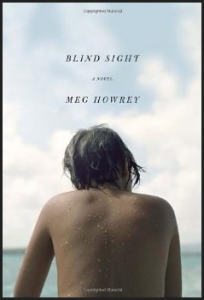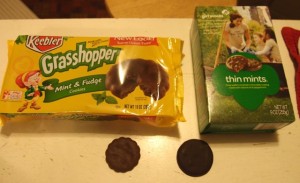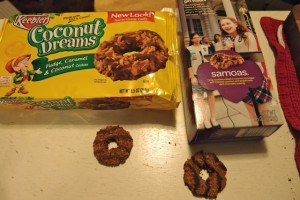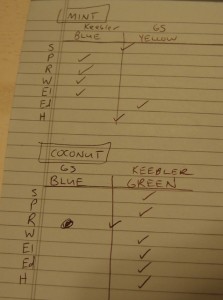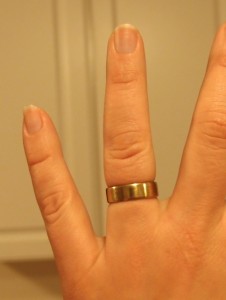It took a week and a half, but I found the way to explain Crohn’s Disease to Edward (and the other kids): “Your immune system is attacking your digestive system. It’s not supposed to, and no one knows why it’s doing it.” There! *brushes off hands*
Oh, wait, now I have to explain something else? Fine. “This medication is supposed to make your immune system relax so that it will stop attacking your digestive system so much. But the only way to do that is to tell the immune system to relax about ALL attacking. So your immune system is also relaxing about attacking germs and viruses. That’s why I said you have to wash your hands before AND after picking your nose.”
I had a little crisis yesterday when we picked up Edward’s new medication and saw that one of the potential side effects is a rare, rapid, fatal cancer. People and literature say, “YOU know what’s best for your child,” but actually I have no idea. How would I know? In fact, THINKING one knows what’s best for someone else is one of the classic plot lines of tragic literature. And do we think of our own parents as being the ones who know what’s best for us?
Here is the way in which it’s true I know what’s best for Edward: I know he often doesn’t really hear things the first time, so I know I need to repeat things and/or get confirmation from him that he’s understood. I know he has even more trouble understanding things if it’s a stranger talking to him, so I know it’s better if I can accompany him to things such as the MRI, to re-state for him each thing the technician says. I also know that if he is having trouble choking down a food or medicine, he really will barf it up if he forces it. This is the type of way in which I “know what’s best” for Edward. Note that even this category is pretty thoroughly dicey: maybe what would be best for Edward is if I STOPPED interpreting/repeating for him, so that he would get used to hearing things without my help; maybe what would be best for Edward is if I stopped trying to make him eat vegetables.
Here is the way in which it’s definitely NOT true I know what’s best for Edward: I don’t know if a medicine is the best one for him, or not. The doctor doesn’t know that either. Neither do any of my friends and family; neither do you. THE ENTIRE SCIENTIFIC/MEDICAL/HEALTH/PEOPLE COMMUNITY DOES NOT KNOW THIS INFORMATION. NONE of us will know until we try it and it either works, or doesn’t, or does something awful. The extent to which any of us BELIEVE we know it ahead of time (or believe afterward that we DID know it) is not correlated to the actual fact of us knowing it. The extent to which the medicine makes any of us nervous is not correlated to its effectiveness or lack thereof, or to the rightness/wrongness of a decision; believing it IS correlated is also uncorrelated.
But beliefs still enter into this HUGELY. There are entire branches of treatment options that I consider complete hooey when I have no reason to consider using those branches of treatment and have nothing at stake. Do I still think they’re hooey now that the patient is my own irreplaceable child? So far: yes. But we’re about 5 minutes into this process. Plenty a person who starts out on one branch ends up dedicating their life to Spreading Awareness after things go wrong.
********
Normally when I bring up a topic, I assume I’m bringing it up for discussion: if I didn’t want to discuss it with other people, I would leave it inside my head where I could discuss it with only myself. Today I’m overwhelmed and all over the place after reading the brochure that comes with a medication (see also: the brochure that comes with almost any medication) and then hearing “Oh, don’t give your child those DANGEROUS TOXIC POISONS! Instead try something you’ve always believed to be absolute hooey!” from someone I’d thought was going to give a very different kind of advice. Also, it’s been a week and a half since we got the diagnosis, and apparently that is about how long it takes me to absorb news.
In short, I am feeling tender and touchy and upset—not an ideal state of mind for discussions. I ate three-quarters of a pound of See’s chocolates yesterday, and I assure you that was the minimum therapeutic dose. So if you’ll allow this presumption, I’d like to GUIDE the discussion more than usual—not to make you feel nervous that anything you say will be the wrong thing, though that seems like an inevitable side effect for people as empathetic and considerate as we are, but more to clarify things ahead of time. The way a friend might arrive at the coffee shop and say, “Heads up: I have PMS, and the baby only let me sleep 2 hours last night, and I had a fight with my JERKHOLE husband right before I came here, so I might be a Bit Cranky,” and you might think to yourself, “Okay, so this would be a GOOD day to insist on doughnuts with our coffee and tell that funny story and have a little vent about spouses, and a BAD day to ask for real marriage advice or to mention the extremely irritating customer service I got the other day or to offer an opinion about the importance of treasuring every moment.”
Anyway, so I’ve come marching into the coffee shop already talking a blue streak, and I realize the topic may SEEM to be “Weigh in on what you think we should do with Edward’s treatment and/or give me alternatives to what the doctor is suggesting” or “Reassure me that I DO know what I’m doing, and that anything that makes me nervous is The Wrong Decision” or “Argue with me about how beliefs relate to reality”—but those are in fact the things that have gotten me all worked up, so although they may be good topics for another day after more mental processing has taken place, they are not good topics for right this minute.
The topic is more like “It’s so hard to know what to do for one’s child, and so hard to collect information when the information is large and group-based but the child is individual, and so upsetting and unhelpful to hear that we DO know when we really DON’T, and so upsetting to be reminded that these awful potential side effects really do happen to real people, and so odd to think about how belief systems do/don’t change based on life circumstances, and so weird to have life circumstances change like this, and so upsetting to feel like anything I choose could potentially be Absolutely Wrong and that then it will be All My Fault.”
Or doughnuts. Doughnuts are a good topic. Or things that comfort you to think of when you are in a similar tizz. (Right now I’m using “Yes, it is horrible that bad things really do happen to real people. But nothing horrible is happening to US right NOW, so there is no need to vividly imagine what it would be like if it WERE,” plus a concept along the lines of waiting to look under the bandage until a little more time has passed, plus the self-administered-medication-only concept of thinking of how many other families at the children’s hospital would want to trade places with us.) Or stories about how something scary worked out perfectly fine, like how my gut was sending me the message that Elizabeth’s tonsillectomy would result in certain fatality, and yet it went perfectly fine. Or general agreement about how life is horrible and hard and we all die no matter what we do.

